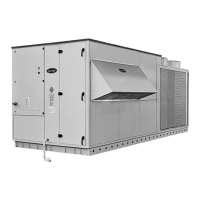• Position the lifting cables on the lifting bars
Evenly positioned spacer bars should be used
between the lifting cables to prevent damage to
the top of the unit and ensure that no excess pressure
is applied to the side panels.
For hoisting ensure that the weight is evenly
distributed and that all previous steps are carried out
correctly.
2.2 - Siting the unit
Always refer to the chapter “Dimensions and clearances”
and service operations. For the centre of gravity coordinates,
the position of the unit mounting holes, and the weight
drawing supplied with the unit.
Typical applications of these units do not require earthquake
CAUTION: Only use slings at the designated lifting points
which are marked on the unit.
Before siting the unit check that:
•
the permitted loading at the site is adequate or that
appropriate strenghtening measures have been taken.
•
the unit is installed level on an even surface (maximum
tolerance is 5 mm in both axes).
•
to ensure access to the components (see dimensional
drawings).
•
the number of support points is adequate and that
they are in the right places.
•
•
if heavy snowfall is likely and long periods of sub-zero
temperatures are normal, provision has to be made to
prevent snow accumulating by raising the unit above
CAUTION: Before lifting the unit, check that all casing
unit with great care. Tilting and jarring can damage the
unit and impair unit operation.
If units are hoisted with rigging, it is advisable to protect coils
against crushing while a unit is being moved. Use struts or a
lifting beam to spread the slings above the unit. Do not tilt
a unit more than 15°.
WARNING: Never push or lever on any of the enclosure
panels of the unit. Only the base of the unit frame is
designed to withstand such stresses.
2.3 - Checks before system start-up
Before the start-up of the refrigeration system, the complete
against installation drawings, dimensional drawings, system
piping and instrumentation diagrams and the wiring diagrams.
Follow national regulations for these checks. If the national
regulation does not specify any details, refer to standard EN
378-2 as follows: External visual installation checks:
• Compare the complete installation with the refrigeration
system and power circuit diagrams.
• Check that all components comply with the design
• Check that all protection documents and equipment
provided by the manufacturer (dimensional drawings,
P&ID, declarations etc.) to comply with the regulations
are present.
• Verify that the environmental safety and protection and
devices and arrangements provided by the manufacturer
to comply with the regulations are in place.
•
by the manufacturer to comply with the regulations
are present.
• Verify the free passage of access and safety routes.
• Verify the instructions and directives to prevent the
deliberate removal of refrigerant gases.
• Verify the installation of connections.
•
routing and connection).
• Verify the quality of welds and other joints.
• Check the protection against mechanical damage.
• Check the protection against heat.
• Check the protection of moving parts.
• Verify the accessibility for maintenance or repair and
to check the piping.
• Verify the status of the valves.
• Verify the quality of the thermal insulation and of the
vapour barriers.
• Ensure that the ventilation in the machine room is
• Check the refrigerant detectors.
8

